 _______
_______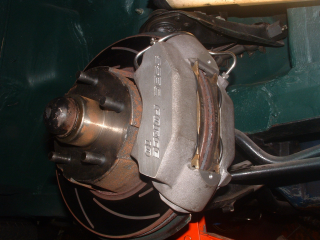
 _______
_______
During a ride of about 10 miles the right front brake began to DRAG very hard and, of course, heat up. I assumed that the pistons in the old calipers were not releasing properly. So I invested in a set of SSBC aluminum calipers. After a bit of a battle with the dust shield and clearance with the inner welds on the styled-steel wheels I got them mounted. They sure looked great. Went for a short ride and all was fine. The next trip to a car show was about 10 miles and guess what, the brakes acted up again. I was very puzzled by this time. I decided that one way this could happen would be if there was a restriction in the right brake line. Since all lines were new stainless steel lines and there were no crimps this did not seem possible. By the way, the left caliper was dragging also just not as bad. I decided that the adjustable proportioning valve might have something to do with the trouble so I backed it off some. I know this should only affect the rear brakes. The problem appeared to be considerably less during the trip home.
I looked at the plumbing of the distribution block and discovered that I didn't hook it up correctly according to the shop manual. I have the right front brake line coming from the rear brake line position on the distribution block and I am using a front port to supply the proportioning valve for the rear brakes. I can't imagine why this makes a difference but it corresponds to the problem. It is going to be difficult to change things around but maybe it will help. I found my drawing for the distribution block as I found it during disassembly. It had been done a third way. Hmmm...
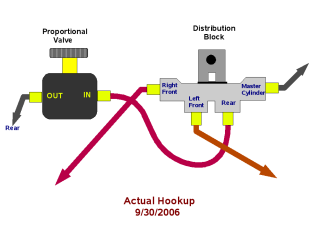 _______
_______
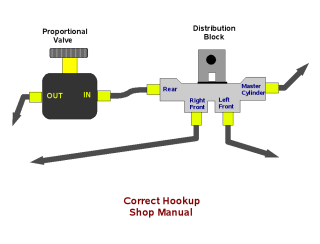
My brother, Alan also described a similar problem he encountered many years ago with a Pontiac TransAm. It seems the front disc brakes would start to drag after a few miles. The problem turned out to be that the push rod from the brake pedal to the master cylinder was too long and when hot would not allow the brakes to release. I will also check this as I fiddled with this when I first put the brakes together because the brake pedal seemed too low. It does not seem low anymore and in fact there seems to be little movement when you apply the brakes. I'll check this first as it is easier than re plumbing the distribution block.
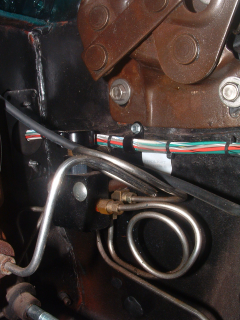
I have tried this experiment. I placed a washer on each bolt between the master cylinder and the firewall. This has the effect of making the pushrod shorter and thus being sure that the master cylinder is fully released. I did take a short test drive and all seemed to be right. I checked the rotor temperatures with a non contact thermometer and found that they were nearly the same around 200 degrees F. I conclude from this that the brakes are being evenly applied. Of course, I need to drive the car at least 10 or more miles before I will know if I have made progress.
More later...
Later: Well the problem reoccurred when CJ and I went to the Grove City cruise-in this June. My son was here last weekend and he likes to help with the car and I enjoy his help. "We" decided to re-plumb the distribution block as the shop manual shows. We hooked up the rear brakes to the rear port of the distribution block. This was somewhat messy and cramped quarters but we made it. Then we had to bleed the system which worked fine but during this Ian remarked that the pedal needed more pressure to bleed the rear brakes than the front calipers but this didn't ring any alarms for us.
We took the car out for a short ride and when I stopped to let him drive I though the brake were dragging. When we got back we found the rear drums were HOT. Sigh! There is something wrong with the rear port on the distribution block. Maybe too much residual pressure. I thought this distribution block was just a piece of brass with 1 input port and three output ports but the more I read the more I think it may have a residual pressure valve.
I was looking for a replacement distribution block when I came across another solution at CJ Pony Parts a dual piston replacement master cylinder and kit for my '65. The best part is that you plug the rear port on the distribution block and use only the front ports. The rear brakes are feed from the front port of the Master cylinder. Click here to see the tech article for this replacement.
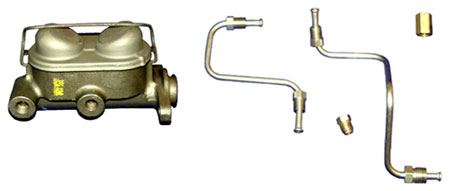 _____
_____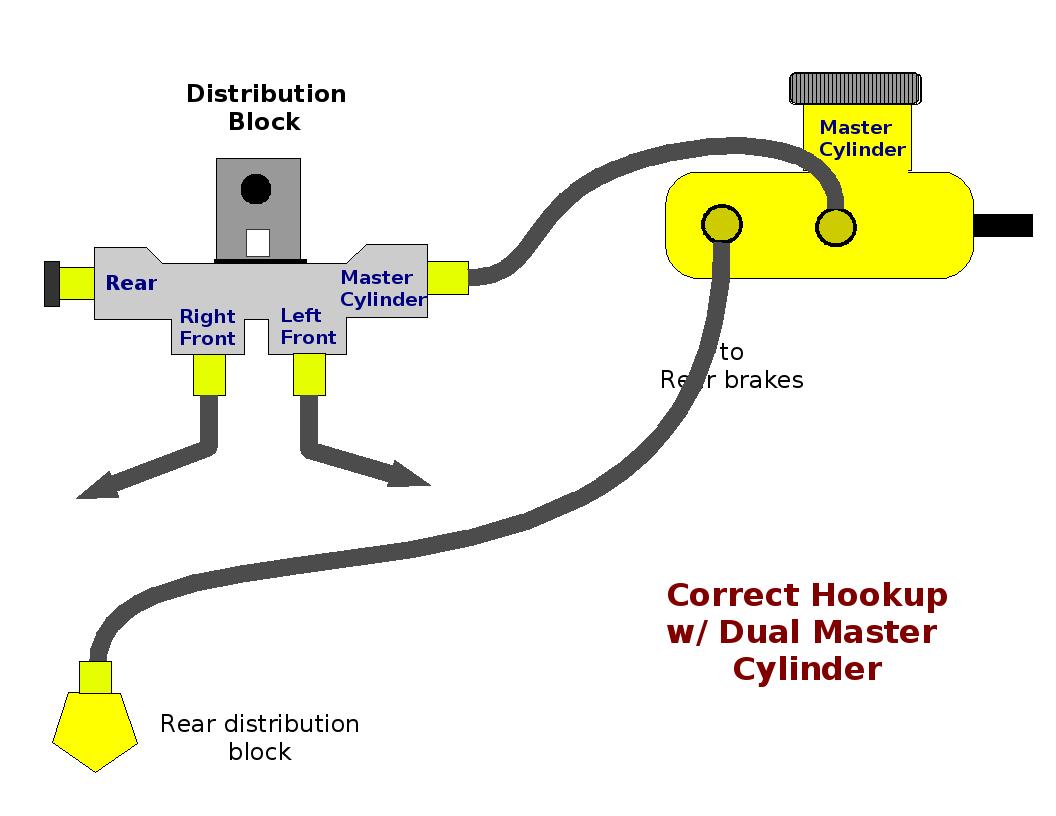
Some more thoughts on the brake problem.
About midnight one night ( morning?) while watching a 007 movie I had a sort of epiphany. I think I now know why the emergency brake system on the mustang was butchered. I suspect previous owners had trouble with the rear brakes dragging. I can just see someone trying things to keep the emergency brakes from dragging and eventually just loosing it and cutting the cables. they must have really been beat when that didn't help. They even went so far as to remove the transfer bars inside the drums. When none of this helped they sold the car to someone else maybe us. The real problem is in the distribution block where the pressure to the rear brakes doesn't bleed off fast enough.
I would never have figured this out if I hadn't plumbed the block wrong and hooked up the rear port to the right front wheel. This, of course, caused the right front caliper to drag after using the brakes. If I would wait a bit most of the pressure would bleed off and the brake would not drag so hard and all would seem okay until I used the brake enough to build up the pressure again or things just expanded as they got hotter and hotter. This became pretty clear after Ian and I re-plumbed the distribution block and the rear brakes started to drag instead of the right front. Duh!
Return to Mustang page